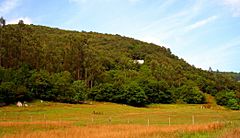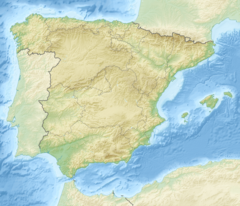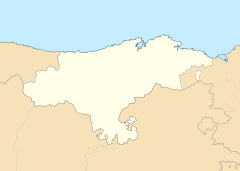La Garma cave complex facts for kids
|
Complejo kárstico del monte de La Garma
|
|

Approach to the cave, entrance covered by a white sheet
|
|
| Location | Cantabria, Spain |
|---|---|
| Coordinates | 43°25′50″N 3°39′57″W / 43.43056°N 3.66583°W |
| Type | karst cave complex |
| Site notes | |
| Condition | excellent |
| Public access | No |
| Official name: La Garma | |
| Type: | Cultural |
| Criteria: | i, iii |
| Designated: | 1985 (9th session) |
| Part of: | Cave of Altamira and Paleolithic Cave Art of Northern Spain |
| Reference #: | 310-014 |
| Region: | Europe and North America |
| Official name: Complejo Kárstico del Monte de la Garma | |
| Type: | Non-movable |
| Criteria: | Archaeological site |
| Designated: | 7 July 1998 |
| Reference #: | RI-55-0000118 |
The La Garma cave complex is a group of caves in Cantabria, Spain. It's famous for its ancient cave art and for being a place where scientists study early humans (this is called paleoanthropology). The caves are located near the village of Omoño.
What makes La Garma special is that it has one of the best-preserved cave floors from the Paleolithic period, also known as the Old Stone Age. This floor holds more than 4,000 fossils and over 500 ancient drawings and symbols. The La Garma complex is so important that it's part of the Cave of Altamira and Paleolithic Cave Art of Northern Spain World Heritage Site. This means it's recognized globally for its cultural value.
Exploring the La Garma Caves
The La Garma cave complex is found on the southern side of La Garma Hill. It's a system of caves that has been used by humans for a very long time, starting about 175,000 years ago and continuing even into the Middle Ages.
The complex includes several important areas:
- La Garma A
- La Garma B
- The Lower Gallery
- La Garma C
- La Garma D
- El Truchiro Cave
La Garma A: The Main Entrance
As of 2016, La Garma A is the only way to get into the cave system. It sits about 80 m (262 ft) above sea level. This part of the cave has many layers of soil and artifacts (called stratigraphy). These layers show that people lived here during different periods, including the Aurignacian, Gravettian, Solutrean, and Magdalenian times. Later periods like the Mesolithic, Neolithic, Chalcolithic, Bronze Age, and Middle Ages are also found here.
La Garma B: A Link to the Past
La Garma B is located about 70 m (230 ft) above sea level. It connects La Garma A to the Lower Gallery. This section contains evidence from the Chalcolithic and Bronze Age. From La Garma B, you can reach the Intermediate Gallery, which has more ancient cave paintings and deposits.
The Lower Gallery: A Time Capsule
The Lower Gallery of La Garma is about 59 m (194 ft) above sea level and stretches for about 300 m (984 ft). It was discovered in November 1995. What makes it amazing is that its original entrance was blocked by a rockslide about 16,000 years ago, during the Pleistocene Ice Age. This rockslide sealed the cave, keeping its floor perfectly preserved.
The Magdalenian Lower Gallery cave floor is one of the best-preserved Paleolithic cave floors ever found. This makes it incredibly important for scientists who study early humans. Researchers have divided this gallery into nine areas. Most of the archaeological finds are in Zones I, III, and IV.
The floor covers an area of more than 500 m2 (5,382 sq ft). Thousands of animal bones and seashells have been found here. There are also tools made from stone, animal antlers, and bones. Scientists also found three stone structures, which might have been places where people lived.
In the older parts of the Lower Gallery, 27 hand stencils in red, red dots, and simple animal paintings in red were discovered. Near the entrance to this section, paintings and remains of living structures from the Middle Magdalenian period were found. A painting of a bison in Zone IX has been dated to around 16,512-17,238 years ago.
La Garma C and D: Ancient Burial Sites
La Garma C and D are located above La Garma A. These sections contain burials from the Chalcolithic period. This shows that people used these parts of the cave as places to bury their dead.
El Truchiro Cave: A Unique Discovery
El Truchiro Cave is about 39 m (128 ft) above sea level. It has layers from the Mesolithic and Chalcolithic periods. A very special discovery here was a burial from the late Mesolithic period, dating to around 5560–5310 BC. An individual was found buried inside a coffin made of oak bark.
Amazing Discoveries
Cave Lion Claws
In the Lower Gallery, scientists found nine claws from an adult cave lion (Panthera spelaea). One of these claws was dated to about 14,800 BC. These claws came from a smaller type of cave lion that lived in Cantabria. The claws show marks similar to those made by modern hunters when they skin an animal to keep its fur. Since no other parts of the cave lion were found, researchers believe these claws are what's left of a cave lion pelt (skin with fur) that was brought into the cave by its ancient inhabitants.
Portable Art: Art You Can Carry
La Garma is also famous for its many examples of Magdalenian portable art found in the Lower Gallery. Portable art means small art pieces that people could carry with them. The most amazing piece is a carving of an ibex (a type of wild goat) on a spatula made from a cow rib. Other portable art found includes decorated sticks, carved bone pieces, decorated stone tablets, and simple pendants.
Ancient Burial Practices
During the Neolithic period, La Garma was used less as a place to live. From the Chalcolithic period through the Bronze Age, it became mainly a shared burial site. This means many people were buried together there. Scientists also found the remains of five young people from the Visigothic period deep inside the cave system. These findings help us understand how ancient people buried their dead.
See also
 In Spanish: Complejo kárstico del monte de La Garma para niños
In Spanish: Complejo kárstico del monte de La Garma para niños
- Caves of Cantabria



